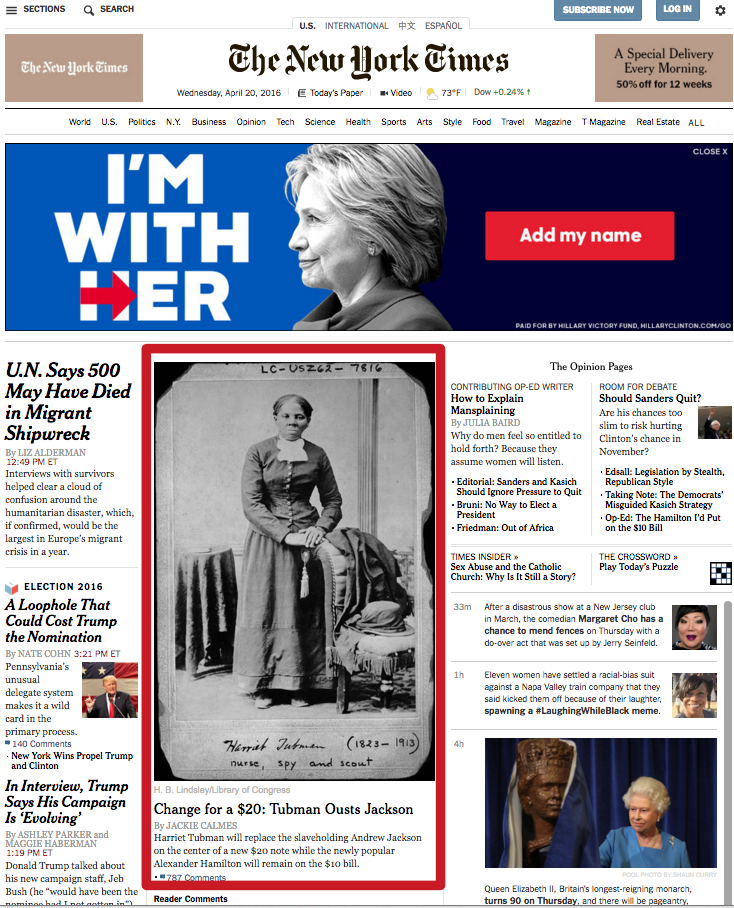The New York Times reported extensively on the Treasury Department’s announcement Wednesday that it would put legendary abolitionist Harriet Tubman on the $20 bill, a far cry from how the newspaper reacted when the American icon died in the early 1900s.
Tubman died on March 10, 1913, and the Times made only three brief mentions of the noted civil rights activist in the following nine months, according to a search of the newspaper’s online archives.
First, the Times claimed in a blurb on March 11 that she was dying.
“Harriet Tubman, a negro woman 95 years old, who knew Abraham Lincoln and William H. Seward and was associated with John Brown in anti-slavery work, is dying here from pneumonia,” read the report, which was filed in Auburn, N.Y.
The brief article was titled “Harriet Tubman Dying; Negro Woman Who Aided Hundreds of Fleeing Slaves Is 95 Years Old.”
“She is in the Harriet Tubman Home for Aged Negroes, which she founded with the aid of Secretary Seward. Harriet Tubman was connected with the ‘underground railroad’ system, by which slaves were aided in fleeing the South. She is said to have piloted more than 300 slaves to Canada,” it read.
Next, the Times published a short, two-paragraph obituary dated March 14.

“Harriet Tubman Davis, an ex-slave, known as the ‘Moses of her people,’ who before the civil war took 300 slaves to Canada through her ‘underground railroad,’ died on Monday night at the home she founded for aged and indigent negroes at Auburn, N.Y.,” the 131-word article began. “She was said to be 98 years old, and her death was caused by pneumonia.”
The obituary suggested that although there were some who admired her, others had reason not to.
“Harriet Tubman Davis was esteemed by such men as Ralph Waldo Emerson, William Lloyd Garrison, Phillips Brooks, Horrace Mann, Ferderick [sic] Douglas, Gerrit Smith, and John Brown, while on the other hand planters and slave owners offered rewards of from $12,000 to $40,000 for her capture during the fifties, at the time when she was taking slaves out of the United States. She had served as scout, nurse, and spy in the Union Army,” it read.
The only other time that the paper mentioned Tubman that year came on Dec. 28, when she appeared in the paper’s “Roster of the Mighty Dead.”
Tubman merited little more than a name drop, and the roster identified her only as an “ex-slave.”
But times have changed.
On Wednesday, the paper reacted immediately to the Treasury Department’s announcement, and published a handful of articles underscoring Tubman’s noble legacy, and applauding the decision to have her replace Andrew Jackson on the $20 bill.
“Treasury Secretary Jacob J. Lew on Wednesday announced the most sweeping and historically symbolic makeover of American currency in a century, proposing to replace the slaveholding Andrew Jackson on the $20 bill with Harriet Tubman, the former slave and abolitionist, and to add women and civil rights leaders to the $5 and $10 notes,” Times reporter Jackie Calmes wrote in an article titled “Women Sweep Redesigns of $5, $10 and $20 Bills.”
Calmes’ article was featured front and center on the Times homepage, bearing the headline, “Change for a $20: Tubman Ousts Jackson.”

There were other articles on the Treasury Department announcement Wednesday, including “Tubman’s In. Jackson’s Out. What’s It Mean?” and “Here Are the New Faces on $5, $10 and $20 Bills.”
The noted abolitionist was featured that same day in the Times “Evening Briefing,” and the story was also trumpeted on the newspaper’s social media sites, including Twitter and Facebook
.
A spokesperson for the New York Public Library, which is in possession of the Times’ complete archives, did not respond to the Washington Examiner’s request for comment.

